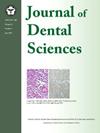MicroRNA let-7a通过靶向高迁移率组AT-hook 2减轻口腔黏膜下纤维化的进展
IF 3.1
3区 医学
Q1 DENTISTRY, ORAL SURGERY & MEDICINE
引用次数: 0
摘要
背景/目的口腔黏膜下纤维化(OSF)是一种不可逆的口腔纤维化疾病,具有很高的恶性转化潜力。MicroRNA lethal-7a (let-7a)已被认为是一种关键的抗纤维化调节因子,但其在OSF中的具体作用尚不清楚。因此,本研究旨在阐明let-7a在OSF进展中的功能意义和分子机制。材料和方法采用实时定量聚合酶链反应(real-time quantitative polymerase chain reaction, pcr)技术,检测从OSF病变中分离的纤维化颊黏膜成纤维细胞(fBMFs)和患者匹配的非纤维化粘膜成纤维细胞(BMFs)中let-7a的表达。使用胶原凝胶收缩、Transwell迁移和伤口愈合试验来评估肌成纤维细胞的特征。分别通过转染let-7a模拟物或抑制剂来恢复和抑制let-7a的表达。利用荧光素酶报告基因法证实let-7a与高迁移率组AT-hook 2 (HMGA2) mRNA的直接结合。结果与患者匹配的非纤维化BMFs相比,从OSF病变中分离的fBMFs中slet -7a的表达显著下调。此外,在槟槟碱诱导的BMFs肌成纤维转分化过程中,let-7a的表达呈剂量依赖性下降。转染let-7a模拟物后,fBMFs的肌成纤维特性,包括细胞收缩性、细胞迁移和伤口愈合能力显著降低。从机制上讲,let-7a直接靶向HMGA2 mRNA,导致HMGA2转录后抑制。重要的是,沉默HMGA2足以降低fBMFs中的细胞收缩性和肌成纤维细胞标记物的表达。结论let-7a通过直接靶向HMGA2抑制口腔肌成纤维细胞的激活。这一发现首次确立了let-7a/HMGA2轴作为缓解OSF进展的有希望的治疗靶点。本文章由计算机程序翻译,如有差异,请以英文原文为准。
MicroRNA let-7a mitigates the progression of oral submucous fibrosis by targeting high-mobility group AT-hook 2
Background/purpose
Oral submucous fibrosis (OSF) is an irreversible fibrotic disorder of the oral cavity with a high potential for malignant transformation. MicroRNA lethal-7a (let-7a) has been recognized as a key antifibrotic regulator, but its specific role in OSF remains unknown. Therefore, this study aimed to elucidate the functional significance and the molecular mechanism of let-7a in OSF progression.
Materials and methods
The expression of let-7a was quantified by real-time quantitative polymerase chain reaction in fibrotic buccal mucosal fibroblasts (fBMFs) isolated from OSF lesions and patient–matched non-fibrotic BMFs (BMFs). Myofibroblastic characteristics were evaluated using collagen-gel contraction, Transwell migration, and wound-healing assays. Restoration and inhibition of let-7a expression were achieved by transfecting let-7a mimics or inhibitors, respectively. Direct binding of let-7a to high-mobility group AT-hook 2 (HMGA2) mRNA was verified using luciferase reporter assay.
Results
Let-7a expression was significantly down-regulated in fBMFs isolated from OSF lesions compared with patient–matched non-fibrotic BMFs. Moreover, let-7a expression declined in a dose–dependent manner during arecoline–induced myofibroblastic transdifferentiation of BMFs. Myofibroblastic characteristics, including cell contractility, cell migration, and wound-healing capacity were significantly decreased in fBMFs after transfection of let-7a mimics. Mechanistically, let-7a directly targeted the HMGA2 mRNA, leading to post-transcriptional repression of HMGA2. Importantly, silencing of HMGA2 was sufficient to diminish cell contractility and myofibroblasts marker expression in fBMFs.
Conclusion
The present study demonstrates that let-7a suppresses oral myofibroblast activation by directly targeting HMGA2. This finding first establishes the let-7a/HMGA2 axis as a promising therapeutic target for mitigating the progression of OSF.
求助全文
通过发布文献求助,成功后即可免费获取论文全文。
去求助
来源期刊

Journal of Dental Sciences
医学-牙科与口腔外科
CiteScore
5.10
自引率
14.30%
发文量
348
审稿时长
6 days
期刊介绍:
he Journal of Dental Sciences (JDS), published quarterly, is the official and open access publication of the Association for Dental Sciences of the Republic of China (ADS-ROC). The precedent journal of the JDS is the Chinese Dental Journal (CDJ) which had already been covered by MEDLINE in 1988. As the CDJ continued to prove its importance in the region, the ADS-ROC decided to move to the international community by publishing an English journal. Hence, the birth of the JDS in 2006. The JDS is indexed in the SCI Expanded since 2008. It is also indexed in Scopus, and EMCare, ScienceDirect, SIIC Data Bases.
The topics covered by the JDS include all fields of basic and clinical dentistry. Some manuscripts focusing on the study of certain endemic diseases such as dental caries and periodontal diseases in particular regions of any country as well as oral pre-cancers, oral cancers, and oral submucous fibrosis related to betel nut chewing habit are also considered for publication. Besides, the JDS also publishes articles about the efficacy of a new treatment modality on oral verrucous hyperplasia or early oral squamous cell carcinoma.
 求助内容:
求助内容: 应助结果提醒方式:
应助结果提醒方式:


